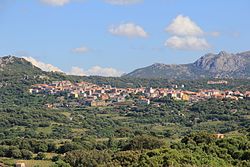Calangianus
 From Wikipedia the free encyclopedia
From Wikipedia the free encyclopedia
Calangianus Caragnani (Gallurese) | |
|---|---|
| Comune di Calangianus | |
 Panorama | |
| Coordinates: 40°55′N 9°12′E / 40.917°N 9.200°E | |
| Country | Italy |
| Region | Sardinia |
| Province | Sassari (SS) |
| Government | |
| • Mayor | Fabio Albieri |
| Area | |
| • Total | 126.35 km2 (48.78 sq mi) |
| Elevation | 518 m (1,699 ft) |
| Population (31 September 2017)[1] | |
| • Total | 4,083 |
| • Density | 32/km2 (84/sq mi) |
| Demonym | Calangianesi |
| Time zone | UTC+1 (CET) |
| • Summer (DST) | UTC+2 (CEST) |
| Postal code | 07023 |
| Dialing code | 079 |
| Website | Official website |
Calangianus (Italian pronunciation: [kalanˈdʒaːnus]; Gallurese: Caragnani [karaˈɲanj]; Sardinian: Calanzanos [kalanˈdzanɔzɔ]) is a municipality in the Province of Sassari in the Italian region Sardinia, located about 190 kilometres (120 mi) north of Cagliari and about 25 kilometres (16 mi) west of Olbia. Calangianus is surrounded by large cork woods, for whose work was described as "Cork's Capital".
History[edit]

The territory of Calangianus has been inhabited since the Bronze Age, and was also settled during the Roma Republic and the Roman Empire. This was proved by the discovery of a multitude of historical piece and archeological sites. Among them are the Tombs of the Giants of Pascaredda, the Fountain "Li Paladini" and 9 "nuraghi", but five of them are destroyed.
In the Middle Ages, Calangianus belonged to the Giudicato of Gallura, and was later ruled by the Aragonese and the Spanish Empire. In the 17th century Calangianus has an important repopulation after several epidemics that scourged Sardinia, and became the second city of Gallura for population. In 1771 it became autonomous. In the early 19th century some entrepreneurs moved to Calangianus, and they transformed the cork forests of Calangianus into a source of wealth. In time, nearly the entire population of Calangianus was working on cork.
The 20th century marked a turning point for Calangianus economic. In the second half of the century Calangianus was home to 300 industries, a number that by 2012 had increased to 677.
Calangianus in 1977 held its first exhibition of cork, and in 1987 obtained the title of one of the hundred most industrialized municipalities of Italy.
Main sights[edit]

- Church of St. Just, built in the 17th century. It is an example of architecture typical of Gallura, completely built of granite and decorated to the smallest detail.
- Church of Santa Maria degli Angeli, built in the 18th century next to the convent of the Capuchin friars. The convent is home to the cork museum.
- The church of Santa Croce and the Oratory Our Lady of the Rosary (16th century). The Our Lady of the Rosary chapel houses the Museum of Sacred Art.
- The church of St. Anne, built in 1665, located in the charming old town of Calangianus.
- The palace La Littranga (18th century)
- The palace Corda, built in the nineteenth century by the first contractor of Calangianus cork.
References[edit]
External links[edit]
- Official website
- www.calangianus.eu - Official Portal of Calangianus in Sardinia/ Archived 2008-04-23 at the Wayback Machine



